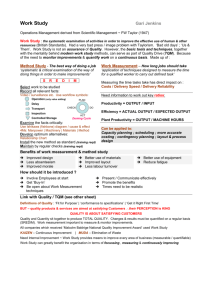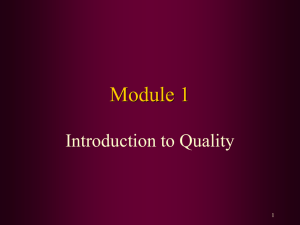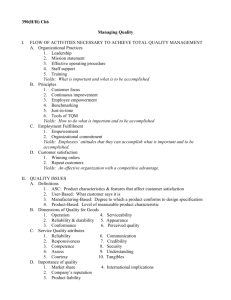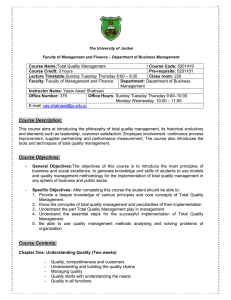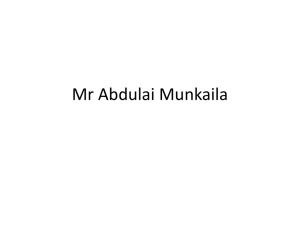Management 9e
advertisement
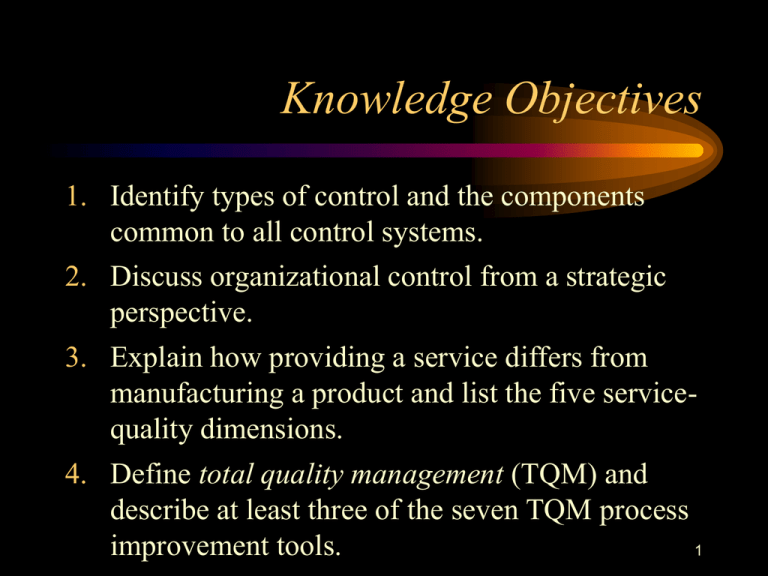
Knowledge Objectives 1. Identify types of control and the components common to all control systems. 2. Discuss organizational control from a strategic perspective. 3. Explain how providing a service differs from manufacturing a product and list the five servicequality dimensions. 4. Define total quality management (TQM) and describe at least three of the seven TQM process improvement tools. 1 Fundamentals of Organizational Control • Control – Taking preventive or corrective action to keep things on track. • Checking, testing, regulation, verification, or adjustment. • Objectives are yardsticks for measuring actual performance. – Purpose of the control function • Get the job done despite environmental, organizational, and behavioral obstacles and uncertainties. – Gen’l Model: Inputs Process Outputs 2 What should be measured? Always measure inputs. The decision to measure process or outputs depends upon the following: • Technically feasible to monitor and measure process? • Do we understand cause and effect? • Cost? • Desired level of innovation? •If impossible to measure process or outputs, then control inputs (e.g., professionalization) 3 Which components to control? Control Inputs When: Control Processes When: Control Outputs When: It is impossible Processes can be to monitor observed & others measured Outputs can be observed & measured Cost of input is Cost of monitoring high is low Cost of measuring is low Quality/safety is important Standardization is critical for quality Cause & Effect is not well understood Cause & Effect is understood Freedom to innovate is desired 4 Which control systems to use? • Feedforward Control – The active anticipation and prevention of problems, rather than passive reaction. Are measurement premises still valid? • Concurrent Control – Monitoring and adjusting ongoing activities and processes. Process and behavioral controls. • Feedback Control – Checking a completed activity and learning from mistakes. Goal setting and responsibility. 5 Components of Organizational Control Systems • Organizational Control Subsystems – – – – – – – Strategic plans Long-range plans Annual operating budget Statistical reports Performance appraisals Policies and procedures Cultural control • Question is …what to emphasize 6 Components of Organizational Control Systems (cont’d) • Objectives – Measurable reference points (targets) for corrective action. – Plan what you can measure, and measure what you plan • Standards – Guideposts on the way to achieving objectives. – Benchmarking: identifying, studying, and building upon the best practices of comparator 7 organizations. Components of Organizational Control Systems (cont’d) • Evaluation-Reward Systems – Measure and reward individual and team contributions to attaining organizational objectives. – Can shape effort-reward expectancies that motivate better performance remember the expectancy theory of motivation!). 8 Components of Organizational Control Systems (cont’d) • Strategic Control – Strategic planning and strategic control go hand in hand. – Top-level strategy sets and/or determines objectives that are “cascaded” down through the organization. – Control measures of supporting activities and results are interpreted and translated up through the organization’s decision making “pyramid”. 9 Components of Organizational Control Systems (cont’d) • Identifying Control Problems – Executive reality checks: top managers periodically working at lower-level jobs to become more aware of operations. – Internal auditing: independent appraisals of organizational operations and systems to assess effectiveness and efficiency. 10 Components of Organizational Control Systems (cont’d) • Identifying Control Problems (cont’d) – Symptoms of inadequate or inappropriate control • • • • • • • • An unexplained decline in revenues or profits. A degradation of service (customer complaints). Employee dissatisfaction . Cash shortages caused by bloated inventories or delinquent accounts receivable. Idle facilities or personnel. Disorganized operations. Excess costs. Evidence of waste and inefficiency. 11 Crisis Management • Organizational Crisis – A low-probability, high impact event that threatens the viability of the organization and is characterized by ambiguity of cause, effect, and means of resolution, and well as by belief that decisions must be made swiftly. 12 Crisis Management (cont’d) • Crisis Management – Anticipating and preparing for events that could damage the organization. • Two Biggest Mistakes Regarding Organizational Crises 1. Ignoring early warning signs of an impending disaster. 2. Denying the existence of a problem when disaster actually strikes. 13 Crisis Management (cont’d) • Developing a Crisis Management Program – Conduct a crisis audit seeking out trouble spots and vulnerabilities. – Formulate contingency plans that specify early warning signals, actions to be taken, and consequences of those actions. – Create crisis management teams with specific skills to deal with a crisis. – Perfect the program through serious practice and rehearsals. 14 The Quality Challenge • Defining Quality – “Conformance to requirements” (Crosby). – Does not address whether requirements are appropriate 15 Five Types of Product Quality • Transcendent Quality – Inherent value or innate excellence apparent to the individual. • Product-Based Quality – The presence or absence of a given product attribute. • User-Based Quality – Quality of the product is determined by its ability to meet the user’s expectations. 16 Five Types of Product Quality (cont’d) • Manufacturing-Based Quality – How well the product conforms to its design specification or blueprint. • Value-Based Quality – How much value each customer separately attributes to the product in calculating their personal cost-benefit ratio. 17 Quality for Service Providers – Distinctive service characteristics • Customers participate directly in the production process. • Services are consumed immediately and cannot be stored. • Services are provided where and when the customer desires. • Services tend to be labor intensive. • Services are intangible. 18 Quality for Service Providers (cont’d) • Defining Service Quality – Five service quality dimensions • • • • • Reliability (most important) Assurance Tangibles Empathy Responsiveness 19 Introduction to Total Quality Management (TQM) • Total Quality Management – Creating an organizational culture committed to the continuous improvement of skills, teamwork, processes, product and service quality, and customer satisfaction. • Four Principles of TQM – – – – Do it right the first time. Be customer-centered (internal/external) Make continuous improvement a way of life. Build teamwork and empowerment. 20 Introduction to Total Quality Management (TQM) (cont’d) • Make Continuous Improvement a Way of Life – Kaizen: a Japanese word meaning continuous improvement (quality is an endless journey). – Potential results • Improved and more consistent product and service quality. • Faster cycle times. • Greater flexibility. • Lower costs and less waste. 21 Introduction to Total Quality Management (TQM) (cont’d) • Build Teamwork and Empowerment – Teamwork • Suggestion systems. • QC circles and self-managed teams. • Team work and cross-functional teams. – Empowerment • • • • Adequate training Access to information and tools Involvement in key decisions Fair rewards for results 22 The Seven Basic TQM Process Improvement Tools • Flow Chart – A graphic display of a sequence of activities and decisions. • Cause-and-Effect Analysis – The fishbone diagram helps visualize important cause-and-effect relationships. • Pareto Analysis (80/20 Analysis) – A bar chart indicating which problem needs the most attention. 23 The Seven Basic TQM Process Improvement Tools (cont’d) • Control Chart – Visual aid showing acceptable and unacceptable variations from the norm for repetitive operations. • Histogram – A bar chart indicating deviations from a standard bell-shaped curve. • Scatter Diagram – A diagram that plots relationships between two variables. 24 The Seven Basic TQM Process Improvement Tools (cont’d) • Run Chart – A trend chart for tracking a variable over time. 25


